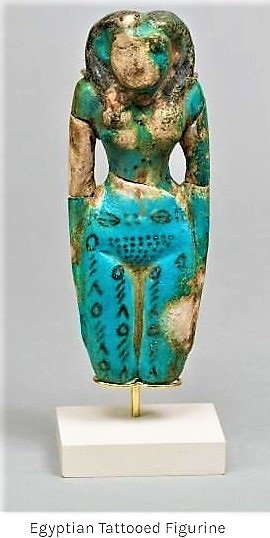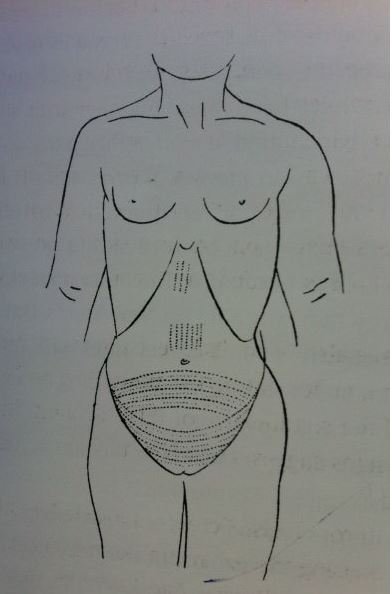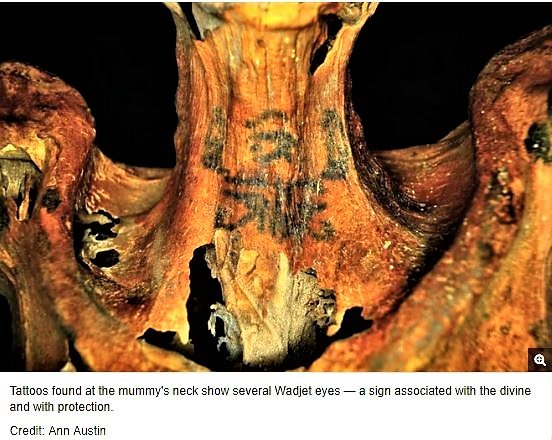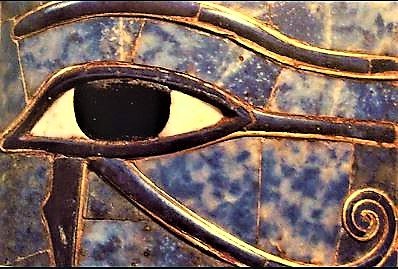Tattooing is belived to have originated in Nubia, in the 4th century B.C. (source: one of Ms. Nancy Etcoff books) In Egypt, tattoos were seemingly only worn by women. As more evidence came to light of tattooed women who were obviously priestesses and members of the court. The concept of cultic tattoos identifying a woman with the worship of Hathor. More than 3,000 years ago, an ancient Egyptian woman tattooed her body with dozens of symbols — including lotus blossoms, cows and divine eyes. Others — such as snakes placed on the upper arms — are also associated with female deities in ancient Egypt.” Additional images known as nefer symbols, “the sign of beauty or goodness,” appeared between them

Although the precise meanings of ancient Egyptian tattoos may be unclear, it seems evident that they had an array of implications and that women of many different social classes chose to wear them.
Two ancient Egyptian female mummies were uncovered from Middle Kingdom Deir el-Bahri; they bore tattoos of geometrically arranged dots and dashes”. The tattoos on these women were the same as those found on Middle Kingdom fertility dolls and that, further, other female mummies were later discovered with similar markings.
Amunet
The Priestess Tattoos

Amunet, a priestess of the goddess Hathor from the 11th Dynasty of the Middle Kingdom. The mummy of Amunet, discovered with the others in 1891 CE by Egyptologist Eugene Grebaut at Deir el-Bahri, shows patterns of tattooed lines on her arms, thighs, and lower abdomen. These tattoos are interpreted by some scholars as fertility symbols and this claim is strengthened by other statues and mummies of tattooed women with the same kinds of marks on their body.
These tattoos are thought to have been worn by a priestess to honor Hathor who, among her many duties, was also goddess of fertility. They were worn by other women as symbolic protection of a child in the womb and during child birth (although these are not mutually exclusive since priestesses could marry and have children). It has been noted that, as a woman’s pregnancy developed and the belly swelled, the tattoos would have formed an intricate net design from one’s lower back to just below one’s navel, thus creating a distinctive protective barrier between the world and the unborn child. The protective aspect of the tattoo is further suggested by the figure of the protector-god Bes which women had tattooed on their inner thigh.
Bes was primarily a protector god of pregnant women and children but was also associated with sexuality, fertility, humor, and joy in life. His image on a woman’s thigh, therefore, could have many meanings within that context and should not be interpreted narrowly as only pertaining to sexual attraction.
The British archaeologist W. M. Flinders Petrie (1853-1942 CE) discovered tattooing tools at Abydos and the town of Gurob dating to c. 3000 BCE and c. 1450 BCE respectively. The Abydos kit consisted of sharp metal points with a wooden handle while the Gurob kit’s needles were bronze. Based upon the tattoos on the mummies, the tattoo artists used a dark pigment of dye, most likely black, blue, or green, with little variation.

The mummy was found at a site on the west bank of the Nile River that housed artisans and workers who built the royal tombs in the Valley of the Kings.
The mummy’s neck, back and shoulders were decorated with images of Wadjet eyes — divine eyes associated with protection.
The position on the woman’s throat — directly over her voice box — may have signaled that whenever the woman spoke or sang, she invoked a ritual power to do good.
Egyptian Mummy’s Symbolic Tattoos Are 1st of Their Kind
The Wadjet Eye

–flickr.com
These colors symbolized life, birth, resurrection, the heavens, and fertility. Although the color black in the modern day is usually associated with death and evil, in ancient Egypt it symbolized life and resurrection. Green was commonly used as a symbol of life and blue, among its many meanings, symbolized fertility and birth. The tattoo artists were most likely older women with experience understanding both the symbols and the significance of the colors. Female seers were commonplace in ancient Egypt, as Egyptologist Rosalie David explains:
In the Deir el-Medina texts, there are references to ‘wise-women‘ and the role they played in predicting future events and their causation. It has been suggested that such seers may have been a regular aspect of practical religion in the New Kingdom and possibly even in earlier times.
ancient.eu/article/1000/tattoos-in-ancient-egypt
The word derives from a Tahitian word which means to strike. Tattoos have been made with boars’ tusk, sea turtle shells, or fine needles which are used to puncture the skin and inject dyes. In the nineteenth century Darwin found tattooed aborigines “from the polar regions in the north to New Zealand in the south.
The art of tattooing goes back millenia, however, and was practiced in ancient Egypt at least as early as the Middle Kingdom (2040-1782 BCE). In ancient cultures such as Greece and Rome the tattoo was worn as a cultic symbol dedicating one to a certain god.
–Source:
Ms. Nancy Etcoff who has an M.Ed. from Harvard University, a Ph.D. in psychology from Boston University, and has held a post-doctoral fellowship in brain and cognitive science at MIT.

No Comments Yet